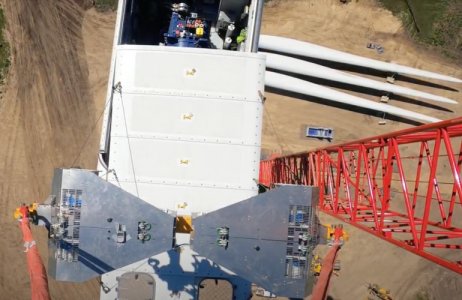Vita Inclinata and M. A. Mortenson Company are conducting a case study to evaluate the potential value a new precision lifting technology can bring to the wind industry. This technology holds the promise of overcoming setbacks associated with wind turbine installations, maintenance and repower projects.
 The single biggest concern on wind turbine installation projects is the effect of wind. The wind poses two interrelated issues: safety and efficiency. Despite existing tools and procedures to reduce the effect of wind, they can be cumbersome and drive additional cost to the project. Reducing or eliminating safety hazards and wind effects are where the Vita Lifting System (VLS) plays a huge role, reducing risk by removing workers and equipment from the load path and improving speed of movement by keeping the load in control, all with a system that is simple to use and maintain.
The single biggest concern on wind turbine installation projects is the effect of wind. The wind poses two interrelated issues: safety and efficiency. Despite existing tools and procedures to reduce the effect of wind, they can be cumbersome and drive additional cost to the project. Reducing or eliminating safety hazards and wind effects are where the Vita Lifting System (VLS) plays a huge role, reducing risk by removing workers and equipment from the load path and improving speed of movement by keeping the load in control, all with a system that is simple to use and maintain.
Mortenson’s vast experience and expertise in wind turbine installation, coupled with its desire to continuously improve operations to yield safer, more cost-effective outcomes, made it a great partner for Vita. A small, innovative business based in Broomfield, Colorado, Vita developed the VLS by applying its lifesaving, aerospace motion control technology to improve operational efficiency while preventing injury and death on construction sites. The two companies came together with an idea for a better way to do business in an industry facing the pressures of rapid expansion.
Through a series of discussions to identify opportunities for the technology, the team mapped out a “crawl, walk, run” evaluation and tech maturation process that has moved from the conference room into the field. The goal is to identify and illustrate the value of precision placement dangers and position hold in the wind turbine installation process, while steadily scaling the technology to meet the demands of the wind project in order to reach a commercialization stage. After a series of data exchanges, a feasibility review and more discussion, the date was set to conduct the first hardware test, a proof-of-concept lift in the Denver area.
Signaling the “graduation exercise” from the “crawl” phase, Vita determined the sizing of a small-scale proxy wind turbine blade (50-ft long x 10,000 lb) and attached the load to the 25-ton VLS Load Navigator (VLN). The team then conducted a variety of crane movement and load positioning maneuvers to demonstrate the effectiveness of the precise position hold and orientation control capabilities of the VLS, as well as the simplicity of the design. Based upon the proof-of-concept results, Mortenson invited Vita representatives to the Dakota Range Wind Project in Watertown, South Dakota, first to observe actual operations and then to perform a light load performance evaluation of the VLN.
Moving to the field in South Dakota initiated the “walk” phase of test and evaluation. During this phase, the VLN demonstrated control of flat, thin, lightweight loads (a 300-lb 12×20-ft nacelle top panel). Historically, this is a difficult lift because there is a high potential for wind updrafts to lift the load and create oscillating motion. The VLN was able to orient the panel to its desired position and hold the panel stable while technicians bolted it in place. Although an atypical lift for a system with 25-ton capacity, it demonstrated to field operators that new technology could make their jobs easier, safer and faster.
While initial lift results were promising, the effort highlighted the critical nature of establishing a partnership to enable new technology to penetrate demanding operating environments. Without Mortenson’s willingness to work with Vita and share its expertise, data, and guidance to identify and refine use cases, Vita would have been unable to rapidly gain insights crucial to take the next step. Determination of the right next step is currently the topic of a fresh series of leadership discussions and approvals revolving around heavier lifts and additional tests to vet the application of Vita’s technology to an expanded array of lifts.
Staying with the “crawl, walk, run” theme, future targets include a “walk graduation” demonstration heavy lift with hardware adapted to provide powerful thrust at scale to control nacelles and turbine blades. Once successful, “run” plans include a full-scale system providing precise control throughout an entire wind turbine installation.
News item from Vita
Filed Under: News




